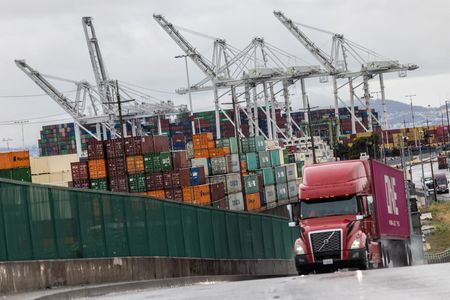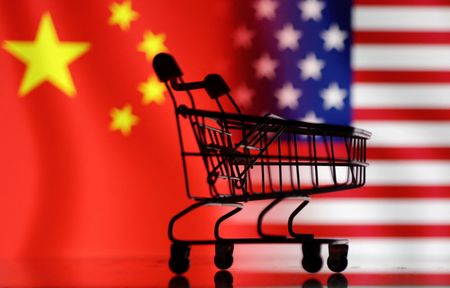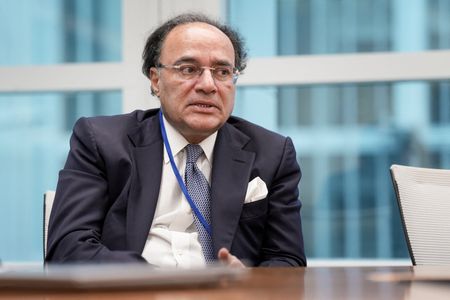By Suzanne McGee
(Reuters) -Investors welcomed the conciliatory tone at U.S.-China trade talks this weekend aimed at cooling a trade war between the world’s two largest economies and dispelling some of the uncertainty clouding financial markets, though few expect a major breakthrough just yet.
In a sign of investor relief that the worst of a U.S.-China trade war might be averted, U.S. stock futures rose on Sunday evening. The S&P 500 E-minis rose 1.3%, while Nasdaq futures added 1.6%.
Both sides declined to elaborate on negotiations, saying that further details will be released on Monday, though U.S. Treasury Secretary Scott Bessent and Trade Representative Jamieson Greer on Sunday said a deal had been reached with China to cut the U.S. trade deficit.
Chinese Vice Premier He Lifeng, who met his U.S. counterparts in Geneva, described the meeting as “candid” and an important first step.
“This is a step in the right direction, showing that both sides are interested in coming to a constructive conclusion and develop a better trade relationship,” said Eric Kuby, the chief investment officer at North Star Investment Management Corp in Chicago.
“The details are quite sketchy, but I think the direction sounds to be more cooperative rather than combative, and I think that we have to view that as a positive.”
The meeting in Switzerland could mark one of the biggest developments since U.S. President Donald Trump launched sweeping tariffs on April 2, which threw the global trade landscape into chaos and set off extreme market volatility.
Recently, investors have expressed optimism that the worst-case trade scenarios would not come to pass, and pointed to signs of de-escalation between the U.S. and China as a reason behind a rebound in equities.
“Markets may be encouraged by some agreement on a deal, but it will remain contingent on further details being released,” said Gennadiy Goldberg, head of U.S. rates strategy at TD Securities in New York.
“Recent price action suggests some optimism around a trade deal. If that turns out to be the case, pricing will have been justified. The risk is if the deal is less substantial than expected. Then the market might come away disappointed.”
Indeed, despite comments by President Donald Trump ahead of the talks suggesting a lower level of Chinese tariffs and a trade deal announced on Thursday between the U.S. and Britain, many market participants said they were not expecting major breakthroughs.
“I’m not sure I would hit the ‘buy’ button on what we have heard today, but if we can make substantive progress with China I think the market will like it,” said Jack Ablin, founding partner and chief investment officer at Cresset Capital in Chicago.
IMMEDIATE PACT SEEN AS UNLIKELY
Both the U.S. and China may want, or even need, to reach a deal, said Liqian Ren, director of Modern Alpha at WisdomTree Asset Management. At this early stage, however, there seems to be little incentive to do so rapidly, she added.
“Each still wants to see how the other side copes with negative headwinds,” Ren said.
“Right now, the market is maybe a little bit too optimistic in terms of what China and the U.S. can achieve and how fast events will move.”
Trade tensions between the two nations escalated last month, when the U.S. boosted tariffs on all Chinese imports to a whopping 145%, and China retaliated by raising levies on U.S. imports to 125%.
On Friday, comments by Trump that an 80% tariff on Chinese goods “seems right” – in his first suggestion of a specific alternative to the 145% levies – created some hope of progress toward resolving the dispute.
The benchmark S&P 500 stock index has already erased the steep losses seen in the immediate aftermath of the tariffs announcement on April 2, although businesses continue to warn investors of their impact and the uncertainty they create.
The S&P 500 remains down about 8% from its February all-time high and roughly 4% for the year.
Amid the tariff chaos, weak consumer sentiment surveys and other “soft data” have raised concerns about U.S. growth, although most economic data has indicated resilience in the economy.
EYEING MARKET VOLATILITY
Volatility remains. The Cboe Volatility Index, the options-based measure of investor anxiety, hovered around 22 late on Friday – well below its recent closing high of 52.33 in early April, but above its longer-term median of 17.6.
One of the factors curbing the volatility has been the high cost of establishing short positions betting on future market declines, said WisdomTree’s Ren.
“When a single (social media post) from the president can make the market move 10%, it becomes very costly” to establish those positions, Ren said. Equities soared on April 9 after Trump paused many of the heftiest tariffs for 90 days.
Still, markets were poised for more volatility ahead, said Matt Gertken, head of geopolitical strategy at BCA, a macroeconomic investment research firm.
Gertken said the firm’s best advice was to “sell on strength.”
Any signs of progress in the initial discussions would be welcome and would allow China to devote more energy to its domestic economic problems, said Andrew Mattock, a portfolio manager at Matthews Asia.
“To talk about any other scenario, you end up with a lose-lose outcome,” he warned.
(Reporting by Suzanne McGee in Providence, Rhode Island; Additional reporting by Laura Matthews, Gertrude Chavez-Dreyfuss, Saeed Azhar, Lewis Krauskopf and Koh Gui Qing in New York, John Revill in Geneva and Amanda Cooper in London; Editing by Matthew Lewis, Edmund Klamann, Ros Russell, Andrea Ricci and Leslie Adler)











